Submarines, warships, naval aircraft: Vietnam shows off maritime muscle at independence day parade
Sign up now: Get insights on Asia's fast-moving developments
Follow topic:
KHANH HOA, Vietnam - In the deep waters of Cam Ranh Bay on the south central coast of Vietnam, some 1,100km from Hanoi, a naval parade was in full swing on a bright summer morning.
Russian-made Gepard 3.9 frigates fitted with guided missiles led the V-shaped formation of surface combat ships, followed by coast guard vessels cutting calmly and confidently through the azure sea. On the deck of a 70m-long Kilo-class submarine, also made in Russia, sailors in crisp white uniforms snapped to salute as helicopters whirled overhead.
“I am so moved, I almost teared up,” said 52-year-old Hanoi resident Nguyen Duc Khanh, who witnessed the spectacle shown across all local broadcast channels. “Our ships are really impressive.”
For the first time on Sept 2, Vietnam’s maritime strength was on public display, featuring submarines, warships and naval aircraft – in addition to the traditional military parade in Hanoi and an aerial display – to mark the country’s 80th national day.
Vietnam has been building up its naval capabilities over the past decade – acquiring assets like Kilo-class submarines and large patrol vessels – to assert its claims and deter Chinese aggression in the energy-rich South China Sea, according to security experts.
Hanoi bought six Kilo-class diesel-electric submarines from Russia in 2009 for around US$2 billion, and these were deployed in 2017. This was a significant investment for an economy that the World Bank estimated at just US$106 billion in 2009.
Like millions of other Vietnamese, Mr Khanh watched the parade on television at home, as he was unable to secure a spot along the pavement where thousands had camped for days to see the troops march past.
The multi-pronged parade is part of a nationwide series of events held throughout 2025 to celebrate the socialist state and its achievements under the leadership of the Communist Party. It is a message of power and sovereignty for the domestic and international audience, military analysts say.
Dr Collin Koh, from the S. Rajaratnam School of International Studies (RSIS) in Singapore, told The Straits Times: “Vietnam’s first maritime parade, in my opinion, was intended to send a simple peacetime signal of deterrence.”
Mr Nguyen The Phuong, a Vietnamese analyst specialising in maritime security at the University of New South Wales (UNSW) in Australia, said Vietnam’s maritime forces were also conveying a message to the domestic audience, that they were “fully capable of protecting the country’s sovereignty”.
The Vietnam People’s Navy has come a long way since 1955, when it was founded as the Department of Coastal Defence with just a small number of canoes and ships, and a few battalions of personnel.
The London-based International Institute for Strategic Studies (IISS) reported in February that the Vietnamese navy currently has around 40,000 personnel, including 27,000 naval infantry troops.
Vietnam’s military expenditures, including naval acquisitions, are not made public, but the think-tank estimated in its report, The Military Balance 2025, that the country’s defence budget stood at US$7.83 billion (S$10.1 billion) in 2025.
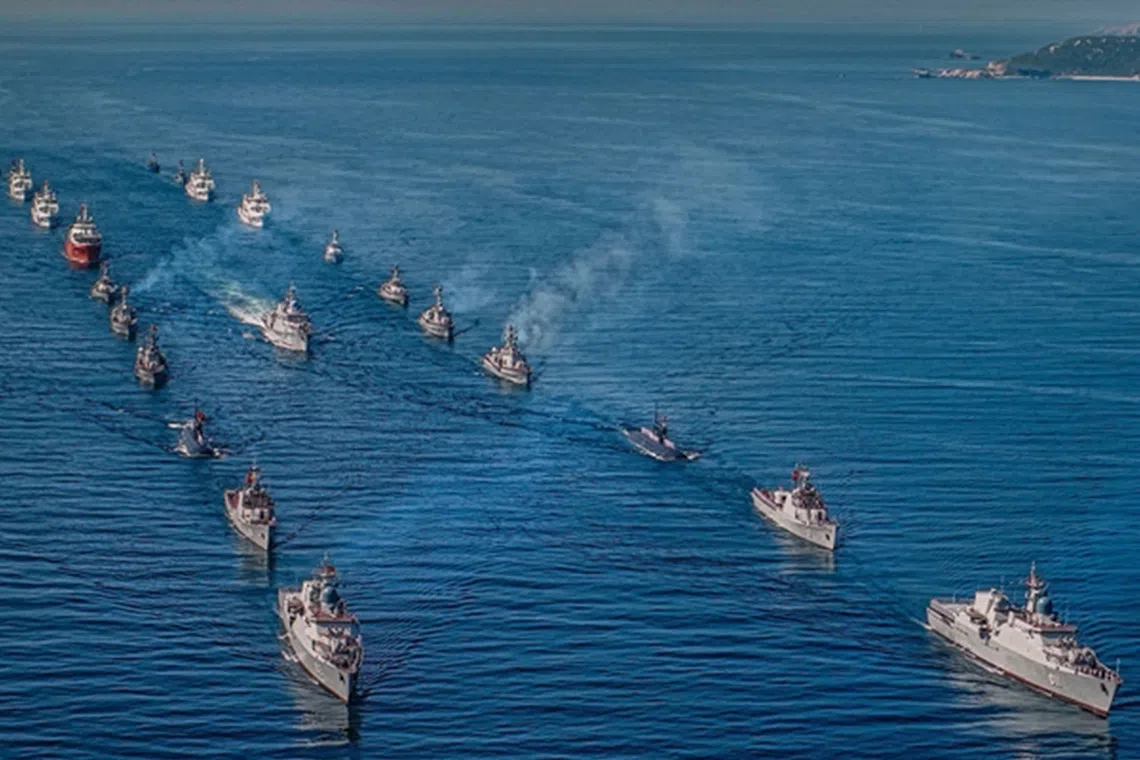
For the first time on Sept 2, Vietnam’s maritime strength was on public display, featuring submarines, warships and naval aircraft to mark its 80th national day.
PHOTO: VIET NAM NEWS/ASIA NEWS NETWORK
According to the Stockholm International Peace Research Institute, it was US$3.82 billion in 2010.
Rear-Admiral Do Minh Thai, the navy’s former deputy chief of staff, told ST: “It has been a remarkable leap, thanks to the right strategy and investment of the (Communist) Party and the government.”
Over the last decade, Vietnam has poured massive resources into modernising its naval force. According to IISS, at present it has the largest submarine fleet in South-east Asia: six Kilo-class diesel-electric and two Yugo-class submarines, in addition to dozens of surface ships, a coastal defence force and a naval air wing.
Vietnam has a long coastline that stretches almost 3,300km from north to south. And the Vietnamese government and the ruling Communist Party have made no secret of the fact that defending the country’s interests in the South China Sea is a top priority and the focus of any military modernisation.
Said Mr Phuong, a PhD candidate in general maritime security and naval affairs: “Before 1975, which is when the Vietnam War ended, Vietnam focused on the continental domain. But after the war, it started to realise the importance of the South China Sea, or the maritime domain.
“When the United Nations Convention on the Law of the Sea (Unclos) was passed in 1982, it gave Hanoi a chance to expand what can be called a ‘maritime living space’, and the need to secure it.”
Unclos is an international treaty that gives official recognition to the maritime boundaries of every country, laying down a comprehensive legal framework for the world’s oceans and seas.
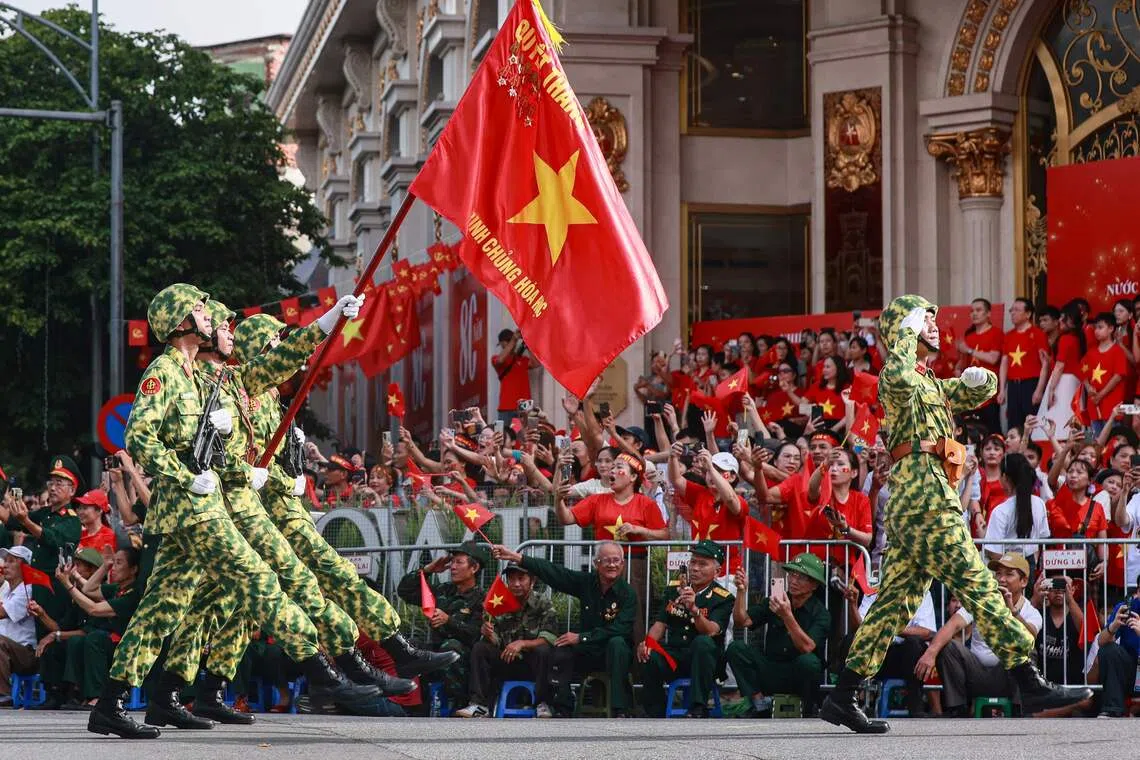
Soldiers marching during a parade marking Vietnam’s 80th National Day celebrations in Hanoi on Sept 2.
PHOTO: AFP
Countering China’s influence
Vietnam and China are among the six parties claiming parts of the South China Sea; however, Beijing’s claims of 80 per cent of the strategic waterway are by far the most expansive. China has the largest navy in the world by number of actively operational ships, and has stepped up its campaign to exert control over a vast area of the South China Sea that it demarcates with a U-shaped line.
While Vietnam’s maritime forces pale in comparison, the goal is not so much to defeat but to deter.
“Vietnam’s strategy behind its maritime forces build-up is mainly defensive in nature, aimed at securing its own maritime domain,” said Dr Koh, a senior fellow at RSIS’ Institute of Defence and Strategic Studies.
“As Vietnam’s primary adversary in the South China Sea is China, there’s no way to bridge that vast military and coast guard power asymmetry, therefore obliging Vietnam to take on a defensive deterrent posture,” he added.
The last time naval forces from Vietnam and China clashed was in 1988 near Johnson South Reef, an atoll in the disputed Spratly archipelago in the South China Sea. The skirmish left 64 Vietnamese soldiers dead and a deep rift in bilateral relations.
“Hanoi has treaded water carefully when it comes to handling the South China Sea disputes with Beijing,” said Dr Koh, noting that Vietnam “refrained from openly naming and shaming China, unlike what Manila does with its assertive transparency strategy”.
Vietnam has not publicly condemned China for its aggression like the Philippines has done, with Hanoi couching its criticism in mild, diplomatic terms.
“This seems to have provided some strategic window of opportunity for Vietnam to push its own agenda, especially the island-building programme,” he said.
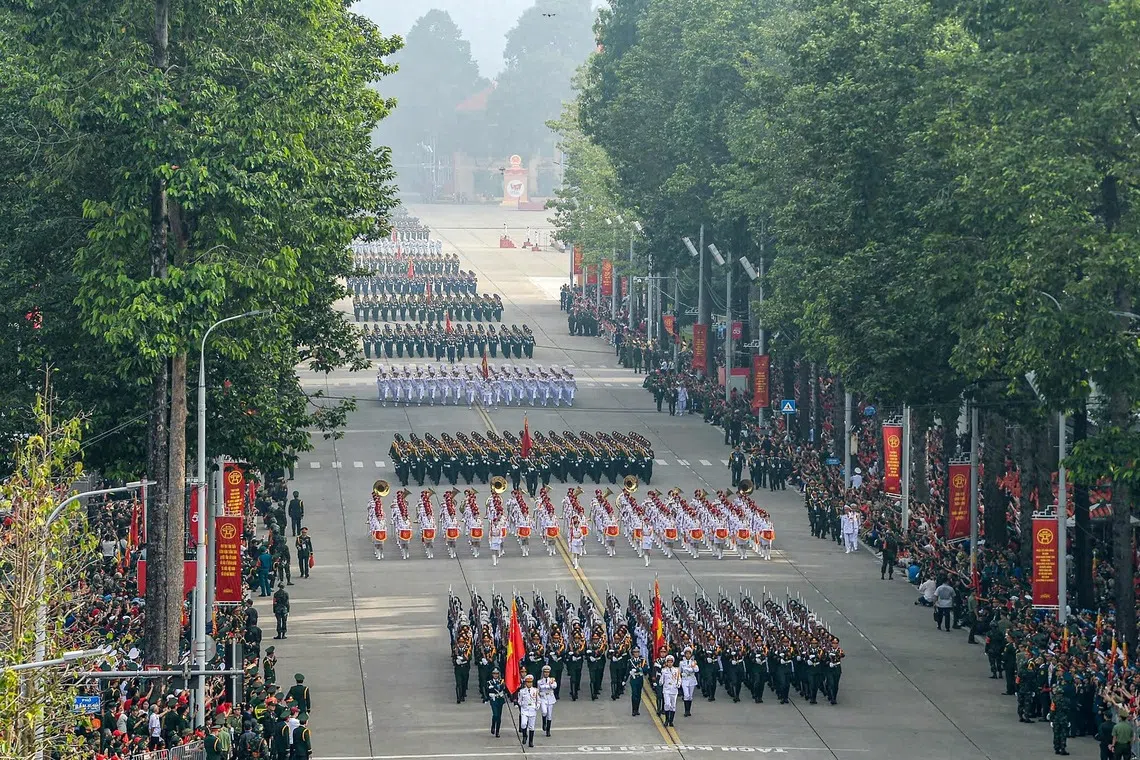
Soldiers marching during a parade marking Vietnam’s 80th National Day celebrations in Hanoi on Sept 2.
PHOTO: AFP
The Asia Maritime Transparency Initiative (AMTI) at the US-based Centre for Strategic and International Studies, in its latest report published in August, said that over the last four years, Vietnam has expanded its island-building efforts at all 21 rocks and low-tide elevations that it occupies in the Spratly Islands.
“As at March 2025, Vietnam had created about 70 per cent as much artificial land in the Spratlys as China had,” AMTI stated, noting that Beijing had reclaimed more than 14.2 sq km of land.
China has also fully militarised three major artificial islands in the Spratlys and equipped them with runways and missile systems.
In August, China responded to Vietnam’s island-building efforts by saying that the Spratly Islands have always been Chinese territory, adding that Beijing firmly opposes construction activities on illegally occupied reefs and islands and will take necessary measures to safeguard its “territorial sovereignty and maritime rights and interests”.
AMTI director Gregory Poling said: “It seems likely that Vietnam is most focused on patrol capabilities and defence (with its island building), as the facilities we are seeing built so far suggest mainly defensive weapons platforms.”
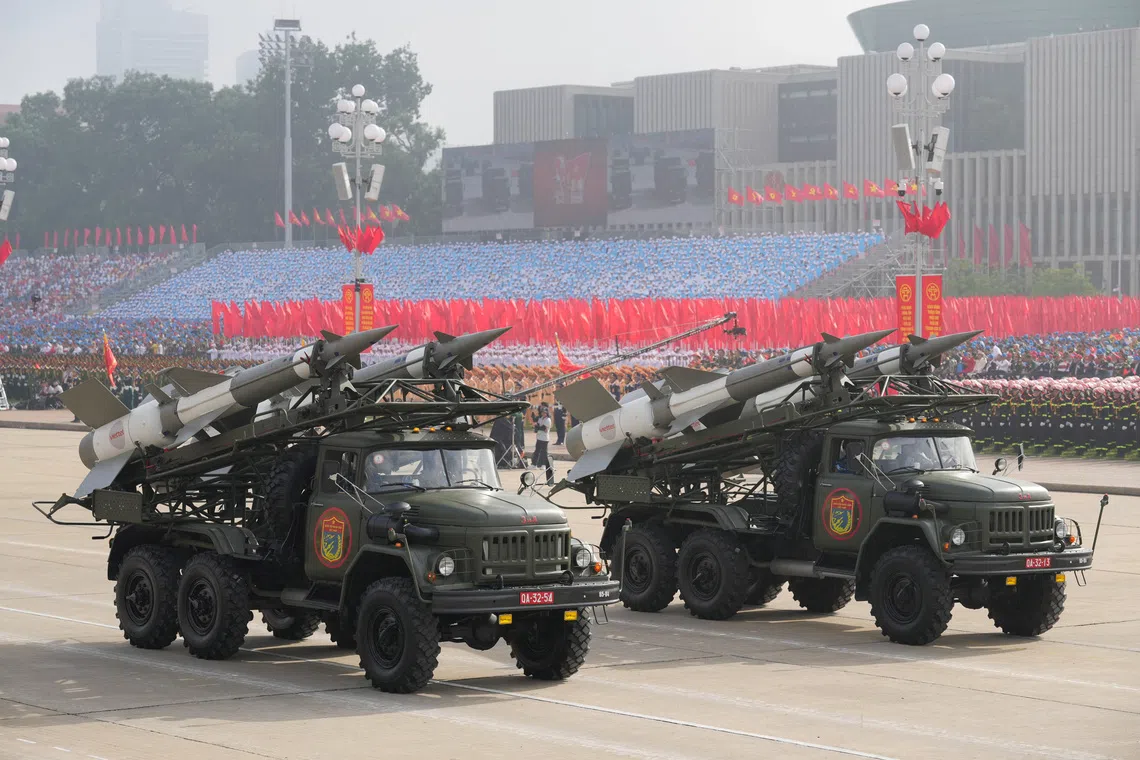
Military vehicles taking part in a parade marking Vietnam’s 80th National Day celebrations in Hanoi on Sept 2.
PHOTO: REUTERS
‘Stuck with Russia far too long’
Yet the Vietnamese navy is in dire need of modernising its technologies and equipment, which presents a massive challenge as the force remains heavily reliant on Russia for both hardware and software.
Senior naval personnel such as Rear-Adm Thai and the force’s commander, Vice-Admiral Tran Thanh Nghiem, were trained in the former Soviet Union. Most of Vietnam’s warships and aircraft, including the submarines, were also built there. “We need more partners – only then can we become technologically independent,” said Rear-Adm Thai.
Only recently has Vietnam added a small number of patrol ships donated by the US and South Korea, as well as French and Canadian aircraft, to its navy and coast guard in a bid to diversify its fleet.
The government passed a decree in late August allowing foreign warships to visit Vietnam up to three times a year per country, instead of only once as previously permitted. Such visits, deemed sensitive in the past, offer an opportunity to exchange information and training for troops.
“The need for diversification became more acute as Russia’s war in Ukraine caused Moscow to prioritise arms deliveries to its own forces,” said the IISS in its February report.
Said UNSW’s Mr Phuong: “In my opinion, we have been stuck with Russia far too long... We have also been too suspicious of Western technologies.”
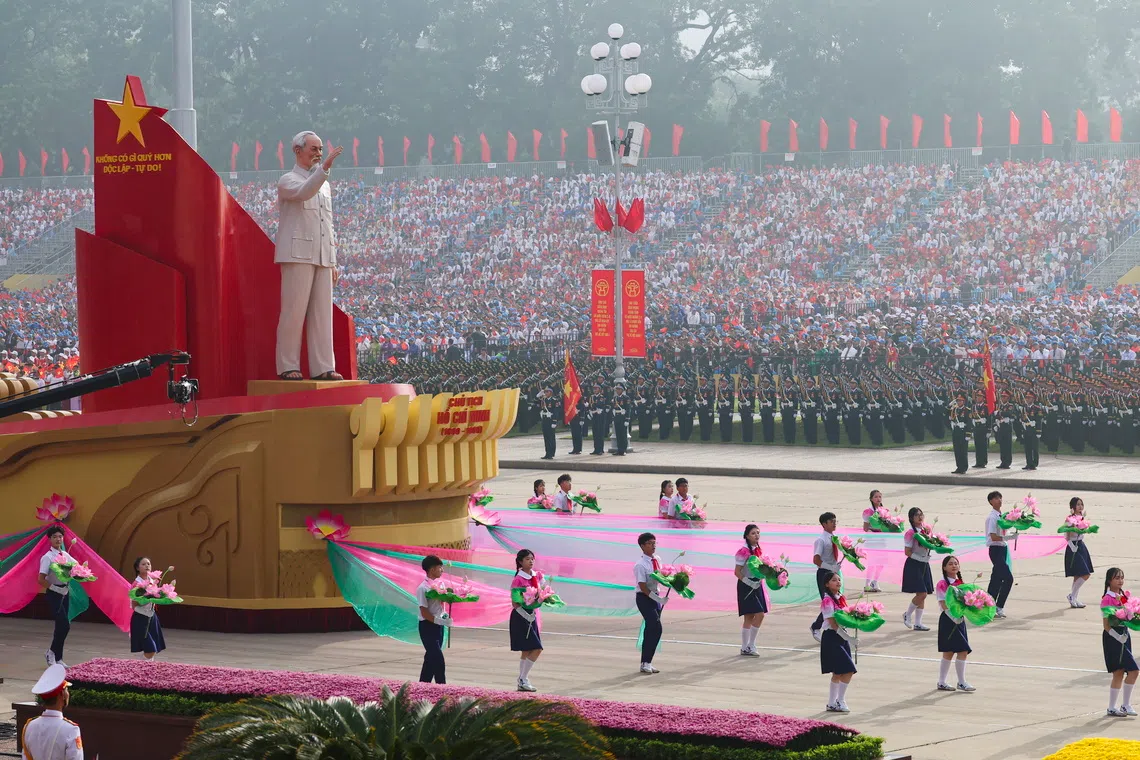
A parade float carrying a statue of Vietnamese leader Ho Chi Minh during a parade marking Vietnam’s 80th National Day celebrations in Hanoi on Sept 2.
PHOTO: EPA
The US lifted its arms embargo on Vietnam in 2016. Since then, it has transferred six Metal Shark patrol boats and three Hamilton-class cutters to the Vietnamese coast guard.
Countries like the Czech Republic, India, Japan and South Korea are also seeking to gain a foothold in Vietnam’s defence market. Hanoi held two international arms fairs in 2022 and 2024 to encourage this trend of modernising and diversifying defence partnerships.
The military has also put more resources into developing its own weapons, especially small arms and artillery.
A Vietnamese shipyard delivered the country’s first locally made missile boat in 2012. Domestic manufacturers have since built small patrol and support vessels based on Russian and Dutch designs for both the navy and the coast guard.
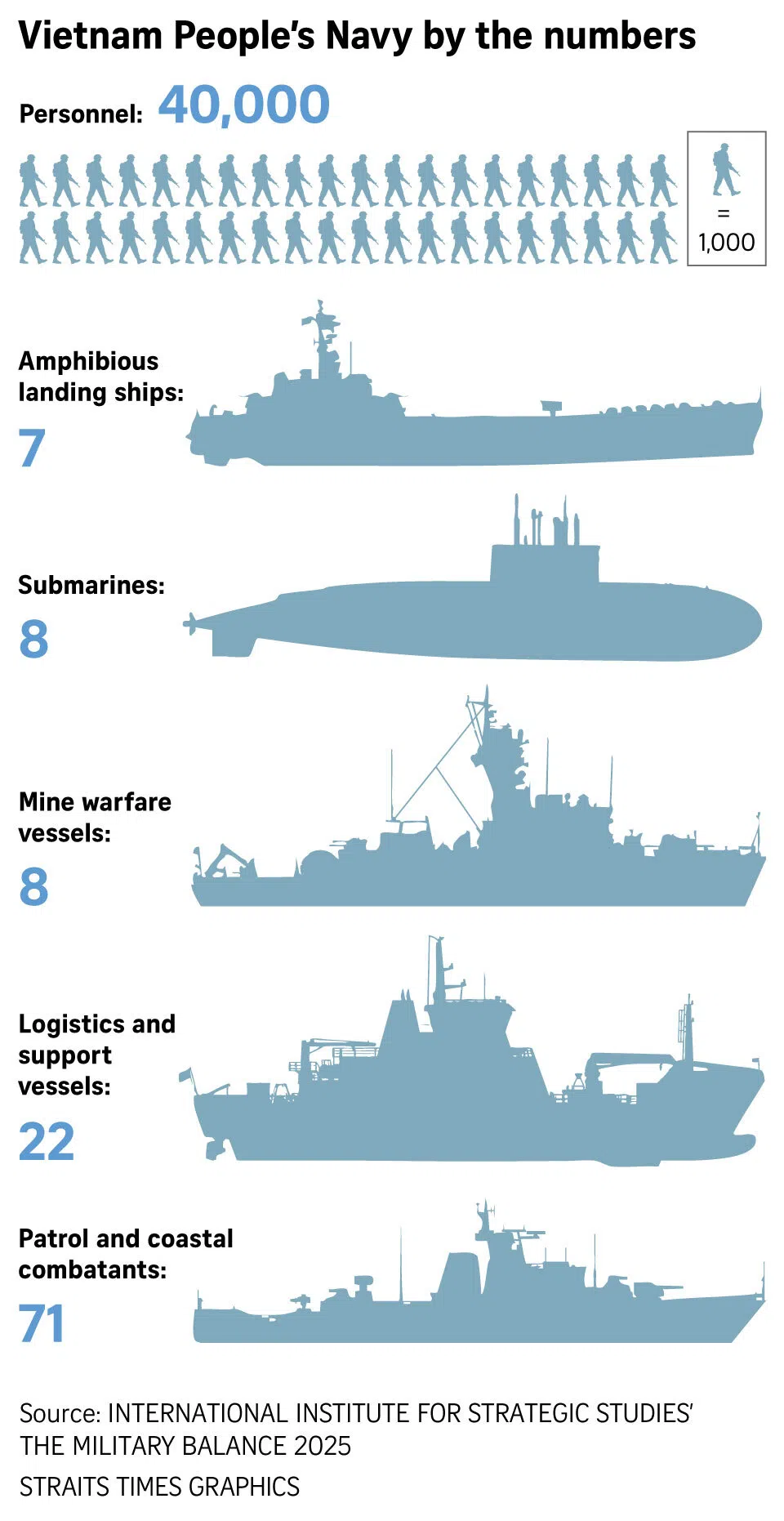
And, despite budget constraints, Vietnam will only continue to bolster its overall defence capabilities, whether it is through international partnerships or beefing up its assets.
“Vietnam’s maritime strategy will focus on two prongs: procuring modern technologies and assets such as new vessels and aircraft, and increasing Vietnam’s presence in the disputed waters,” said Mr Phuong.
As some of these naval and military assets were rolled out onto the waters and the streets on Sept 2, those watching the celebratory parade live along the streets of Hanoi grew fervent with excitement.
“I am very happy to see the military parade today,” said Mr Nguyen Minh Nhut, 48, a driver in Cam Ranh.
“I think we (Vietnam) are totally capable of producing our own weapons, so hopefully there will be more Vietnamese-made ships in the future.”


